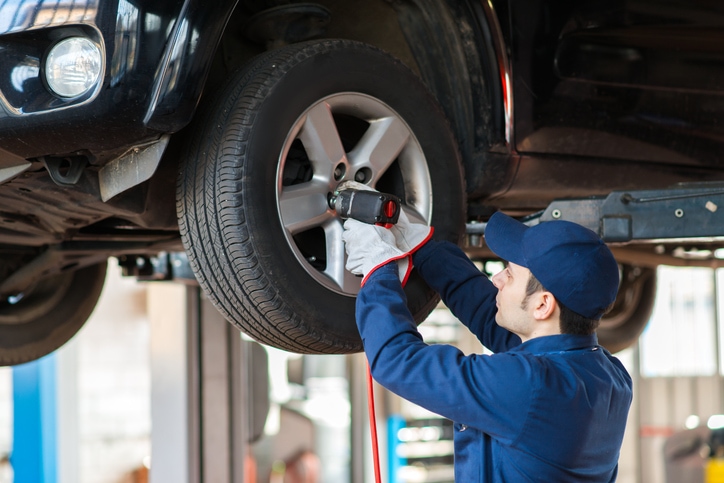All Categories
Featured
Tire turnings are one of the most basic yet most reliable upkeep tasks to ensure your vehicle runs smoothly and securely. This regular service rearranges tire wear, providing many advantages for your car's performance, safety and security, and your budget.
What Does Tire Rotation Involve?
Tire rotation is the process of occasionally altering the setting of each tire on your automobile. For instance, front tires may be swapped with rear ones, or tires might be relocated diagonally. The specific pattern depends on factors like your car's drivetrain (front-wheel, rear-wheel, or all-wheel drive) and the kind of tires you have.
![]()
Why Tire Turnings Are Critical
Advertises Even Step Use. Different tires birth different quantities of weight and anxiety relying on their placement. Because they handle guiding and stopping, front tires often wear quicker. Normal turnings balance out the wear, making certain all four tires have similar tread midsts.
Expands Tire Lifespan. Irregular wear causes early tire substitutes. Turning your tires can expand their life expectancy, saving you money in time.
Enhances Automobile Performance. Well balanced tires boost stability, handling, and traction. Whether you're collaring, braking, or driving on unsafe roadways, equally used tires guarantee a smoother and more secure driving experience.
![]()
Improves Gas Efficiency. Tires with irregular walk wear can create extra rolling resistance, that makes your engine job more difficult and eats more fuel. Routine rotations aid keep optimum gas performance.
Guarantees Safety And Security. Worn tires can endanger braking distance and control. By turning your tires, you keep even decrease the risk and use of blowouts or skidding.
Exactly How Often Should You Revolve Your Tires?
Experts recommend revolving your tires every 5,000 to 7,500 miles. A convenient approach is to couple tire rotations with oil adjustments. Always consult your vehicle's owner manual for details guidelines.
Usual Rotation Patterns
Rotation patterns depend on your car's drivetrain and tire type:
Front-Wheel Drive (FWD): Front tires transfer to the rear, and rear tires cross to the front.
Rear-Wheel Drive (RWD): Rear tires relocate to the front, and front tires go across to the rear.
Four-wheel Drive (AWD): Tires comply with an "X" pattern to make sure well balanced wear.
Directional Tires: These tires should remain on the very same side of the car and are exchanged front to back.
Indicators Your Tires Need Rotation
Uneven tread wear.
![]()
Minimized fuel effectiveness.
Vibrations while driving, specifically at high speeds.
Problem managing the automobile in damaging weather.
Final Ideas
Tire turnings are a simple method to secure your investment and boost your driving experience. By redistributing wear, you can extend the life of your tires, improve fuel efficiency, and guarantee your safety when traveling. Set up regular tire turnings with a trusted technician and make it a consistent component of your automobile's upkeep regimen.
What Does Tire Rotation Involve?
Tire rotation is the process of occasionally altering the setting of each tire on your automobile. For instance, front tires may be swapped with rear ones, or tires might be relocated diagonally. The specific pattern depends on factors like your car's drivetrain (front-wheel, rear-wheel, or all-wheel drive) and the kind of tires you have.

Why Tire Turnings Are Critical
Advertises Even Step Use. Different tires birth different quantities of weight and anxiety relying on their placement. Because they handle guiding and stopping, front tires often wear quicker. Normal turnings balance out the wear, making certain all four tires have similar tread midsts.
Expands Tire Lifespan. Irregular wear causes early tire substitutes. Turning your tires can expand their life expectancy, saving you money in time.
Enhances Automobile Performance. Well balanced tires boost stability, handling, and traction. Whether you're collaring, braking, or driving on unsafe roadways, equally used tires guarantee a smoother and more secure driving experience.

Improves Gas Efficiency. Tires with irregular walk wear can create extra rolling resistance, that makes your engine job more difficult and eats more fuel. Routine rotations aid keep optimum gas performance.
Guarantees Safety And Security. Worn tires can endanger braking distance and control. By turning your tires, you keep even decrease the risk and use of blowouts or skidding.
Exactly How Often Should You Revolve Your Tires?
Experts recommend revolving your tires every 5,000 to 7,500 miles. A convenient approach is to couple tire rotations with oil adjustments. Always consult your vehicle's owner manual for details guidelines.
Usual Rotation Patterns
Rotation patterns depend on your car's drivetrain and tire type:
Front-Wheel Drive (FWD): Front tires transfer to the rear, and rear tires cross to the front.
Rear-Wheel Drive (RWD): Rear tires relocate to the front, and front tires go across to the rear.
Four-wheel Drive (AWD): Tires comply with an "X" pattern to make sure well balanced wear.
Directional Tires: These tires should remain on the very same side of the car and are exchanged front to back.
Indicators Your Tires Need Rotation
Uneven tread wear.

Minimized fuel effectiveness.
Vibrations while driving, specifically at high speeds.
Problem managing the automobile in damaging weather.
Final Ideas
Tire turnings are a simple method to secure your investment and boost your driving experience. By redistributing wear, you can extend the life of your tires, improve fuel efficiency, and guarantee your safety when traveling. Set up regular tire turnings with a trusted technician and make it a consistent component of your automobile's upkeep regimen.
Latest Posts
The Restroom Upgrade Every Detroit Home Is Worthy Of
Published Apr 19, 25
1 min read
Affordable Car Repair Services at Montclare Auto Repair - Don’t Wait, Act Now!
Published Apr 19, 25
2 min read
Unlock Exclusive Discounts with WyHy's Love My Lending institution Rewards
Published Apr 19, 25
1 min read
More
Latest Posts
The Restroom Upgrade Every Detroit Home Is Worthy Of
Published Apr 19, 25
1 min read
Affordable Car Repair Services at Montclare Auto Repair - Don’t Wait, Act Now!
Published Apr 19, 25
2 min read
Unlock Exclusive Discounts with WyHy's Love My Lending institution Rewards
Published Apr 19, 25
1 min read